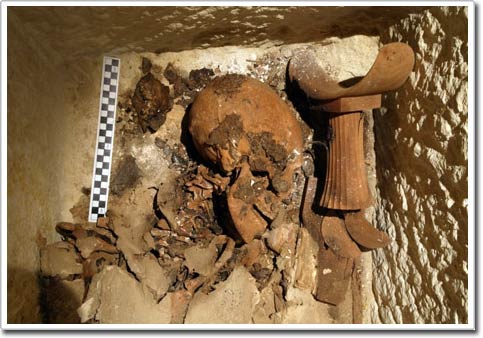A rare tomb of an ancient Egyptian official
Steven Stanek in Cairo, Egypt
Archaeologists have unearthed an intact crypt of an ancient Egyptian official, revealing important details about the burial method of the ancient middle class.
The humble tomb belonged to a clergy and politician of the 5th dynasty named Neferinpu was discovered in 2006 in Abusir, the ' city of the ancient dead ' between the 5th and 26th dynasties. , located near Cairo today. However, just recently a Czech archaeological group excavated this tomb and found a small room 10 meters from the ground filled with intact offerings and personal possessions for nearly 4,500 years.
Miroslav Barta, commander of the archaeological team, said: 'The most important conclusion from this discovery is that everything we find is intact, meaning no one has ever seen or moved from the Old World.' Very rarely, the tomb of a middle-class official like Neferinpu - rank just behind the royal family and on all other classes - was discovered intact.
Barta said: 'This grave does not contain gold or silver but the information it provides makes it unique . ' Last year, his archaeological team discovered four other tombs that were poorer than this tomb, almost nothing but human bones. 'Ancient Egyptian archeology today is not only about discovering beautiful things but information.'
Inside the crypt
The archaeological group found Neferinpu's tomb behind a mud-brick wall to the east of an ancient crypt.
Barta said: 'Within a few hours, we knew that the grave in front of us had never been robbed. I was extremely excited for a few seconds. After this brief time has passed, the only sense of responsibility is to do the best for the grave and its owner. '

Neferinpu's skull, an ancient Egyptian middle-class official.Neferinpu's tomb was found to be completely intact.(Photo: Miroslav Barta, National Geographic)
Inside an area of about 8 square meters, the archaeological group found dozens of sacrifices, including 10 sealed beer containers, more than 80 miniature limestone containers, a small bottle of perfume, plates and separates meaning symbols of food and water. These include 4 flat bottom flasks known as ' canopies ', used to contain organs removed from the body during embalming.
Beneath the lid of the coffin, the mummy was heavily decomposed because it was buried before the preservation methods were completed. The body was inlaid with hundreds of porcelain beads, the mandarin's cane was about 2 meters long and was decorated at the top with gold pieces buried right next to him.
According to Tarek El-Awadi, an official at the Egyptian Supreme Archeology Council (SCA) and responsible for the main survey at Abusir, the coffin also contained a wooden scepter that Neferinpu held with his left hand to prove the level my rank
Rare discovery
According to the carvings on a tomb door, Neferinpu served under the kings of the 5th dynasty, Neferirkara (2475 to 2455 BC) and Nyuserra (2445 to 2421 BC).
According to Barta, the character plays a dual role - a clergy and a mandarin and is probably responsible for construction projects, a familiar role for the officials at the time. Although these positions seem important, such officials are not listed as high-class in society and their tombs are often modest.
Salima Ikram, professor of Egyptian studies at the American University - Cairo said: ' He is rich, but not the richest. He must not be like the chief. These details provide interesting information about classes in Egyptian society. These are details of a non-high-level character and what is most accurate about that rank. '
According to Barta, this crypt corresponds to the information about the 5th dynasty officials. These people are more loyal to the throne than their successors in the 6th dynasty.
'In the sixth dynasty, tombs were often richer because of the decadence of management and officials became more and more independent. However, this character is quite loyal when the career, architecture, size, and graves attached to the tomb are decided by a single person: the King. '
Luck
Barta said it was possible that the tomb of Neferinpu was intact thanks to its humble architecture and random location. An opposite grave located at the end of the crypt to the west was robbed of the antiquity. Usually grave robbers find graves in the west. In this special case, the grave was broken from another grave that was inaccessible to the western part, so this tomb escaped attention.
SCA's El-Awadi, who claims the looted grave is a more attractive target for thieves because of the wealth buried in the grave.'The tomb and the coffin are in very good condition. It is better built, more beautiful and richer. In contrast, Neferinpu's grave was very sketchy, it was not polished and very inadequate. Thieves know they won't find anything there. "
Scientists say the finding is a rare and consistent finding about the lives and deaths of those not belonging to the ancient Egyptian royal family.
- Egyptian life recreated in the ancient tomb
- Stunned discovery in ancient tomb 'human soup' in Egypt
- Identify the Egyptian pharaoh in the ancient tomb
- Excavation of the grave of ancient Egyptian priests
- The ancient Egyptian tomb may contain the forgotten pharaoh's corpse
- The tomb of 3000-year-old woman was discovered
- Discovered a large tomb in ancient cemetery in Egypt
- The 4,000-year-old burial room of the ancient Egyptian official
- Egyptian Pharaoh and deadly curse
- The mummy of a woman intact 3,000 years in the ancient tomb of Egypt
- Egypt discovered an ancient tomb more than 3,500 years containing many antiques
- Discovered a new ancient Egyptian king
 Discovered an ancient centipede fossil 99 million years old
Discovered an ancient centipede fossil 99 million years old Discovered bat-like dinosaurs in China
Discovered bat-like dinosaurs in China Discovered a 200-year-old bronze cannon of the coast
Discovered a 200-year-old bronze cannon of the coast Discover 305 million-year-old spider fossils
Discover 305 million-year-old spider fossils